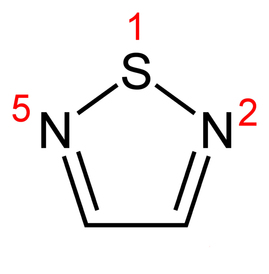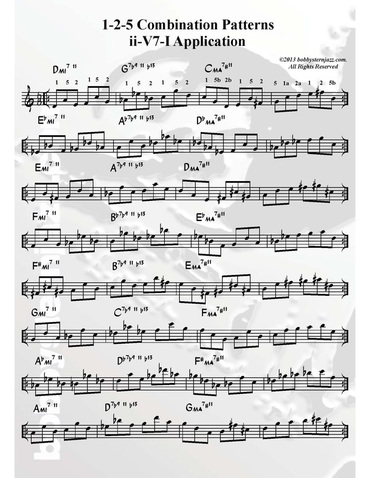
Each three note, 1-2-5 unit has six basic shape combinations: 125, 152, 215, 251, 512 & 521.
Adding a second 1-2-5 grouping, a major 3rd apart (Maj 7#11) or minor 3rd apart (min 7 11) increases that number to 36 (eg. 125-125, 125-152, 215-125, 512-251, etc.) in each case.
 Click for larger view
Click for larger view Then there are the inversions of each 3 note pattern (eg. ascending: 125 C-D-G, 251a D-G-Ca, 51a2a G-Ca-Da ; descending: 521 G-D-C, 251b D-C-Gb, 15b2b C-Gb-Db), which extend above and/ or below the range of the basic 125 unit which is a perfect fifth, thus adding further numbers of possible combinations.
You do the math; I can't count that far.
The exercise presented here is an attempt to utilize these 1-2-5 patterns within in a standard ii-V7-I progression.
The hexatonic material generated by combining a pair of 1-2-5 groupings, a Major 3rd apart, could be viewed as an upper structure to various roots.
One way to create a line over a dominant 7 would be to combine two 1-2-5 groups Maj 3rd apart, starting one half step above the root.
This translates (see second measure of the exercise) into a line created over a ii-V7-I in C (D min7 / G7/ CMaj7#11 / CMaj7#11 / by combining shape combinations 152 (Ab-Eb-Bb) & 152 (C-G-D) over a G root. This creates a G7sus b9 #9 b13, to be exact, and works very nicely.
It can also be seen as a Ab Maj 7 #11, (formed by the two 1-2-5 groups) over a G bass.
1-2-5 patterns are a great way to create melodic lines intervalically and as an alternative to standard bebop type lines.
This example is but one out of an almost infinite number of possibilities to create fresh, interesting, hip sounding lines this way.
Just one more road that leads to "Rome"!
It ain't rocket science, but science nonetheless. Besides, music can take you beyond where any rocket can go..... past, present or future!
More to come on 1-2-5 patterns in my forthcoming e-Book, "Slick Licks That Stick! II". Stay tuned!
 RSS Feed
RSS Feed









